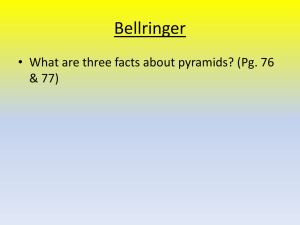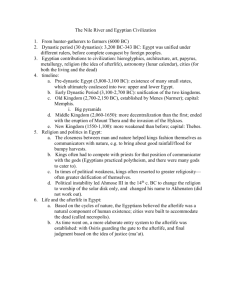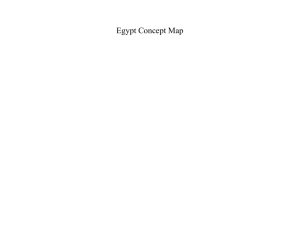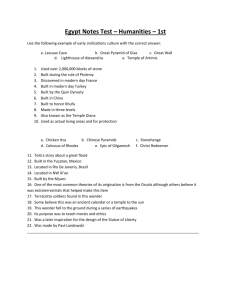Egypt
advertisement
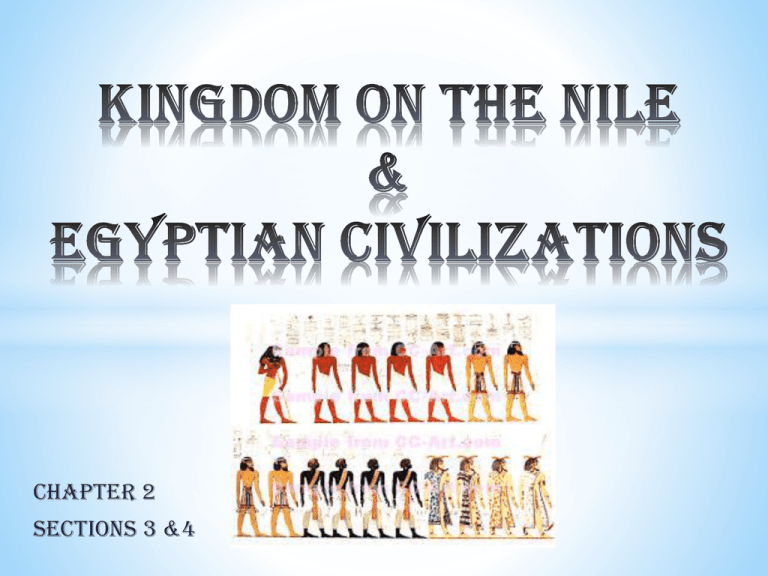
Chapter 2 Sections 3 &4 Geography Helps Shape Egypt Note that Egypt was settled between water systems and desert…both served as a protection from invaders. Ancient Egypt had two distinct regions, Upper Egypt in the south and Lower Egypt in the north. ~3100 bc Old Kingdom (~2575bc2130bc) Middle Kingdom (~1938bc1630bc)) New Kingdom (~1539bc-1075bc) The old kingdom Forms *Pharaohs were Egyptian Kings with complete power. The Egyptians believed the pharaoh was a god. *At the start of their reigns, the pharaohs began building their tombs. These tombs were located within the pyramids. Bureaucracy Pharos depended on Vizier (chief minister to supervise government *Power struggles *Crop failure *Expensive pyramids *Fall of Old Kingdom *Eventually pharos reunite *Middle Kingdom The turbulent middle kingdom * Issues during Middle Kingdom * The Nile did not rise regularly * Corruption * Rebellions * Hyksos were invaders that took over the Nile Delta. The Egyptians were impressed by their chariots and the Hyksos adopted aspects of their civilization. ~1700bc Use your book to find information about each person, god, or goddess. Summarize his/her importance in one sentence and be prepared to share with the class. 1. Hatshepsut 2. Thutmose III 3. Ramses II 4. Amon-Re 5. Osiris 6. Isis 7. Tutankhamen Begins on page 47 New kingdom Egypt grows strong * Hatshepsut: 1st female ruler 1472bc1458bc (encouraged trade) * Thutmose III: Military general that extended Egypt’s borders to greatest extent ever * Ramses II: Extended the borders north again. *` Often boasted of his accomplishments 1279bc-1213bc There were many battles fought with the Hittites until a peace treaty was agreed upon. 1st peace treaty in history New Kingdom * After 1130bc, Egyptian power slowly declined * Invasions by the Assyrians & Persians * 332bc, the last Egyptian dynasty ended, Greeks took control * 30bc, Romans displaced the Greeks Everyone wanted the fertile Nile Religion Shapes life in Ancient Egypt * Amon-Re, was the great lord of the gods * Pharos received right to rule from Amon-Re * Osiris: God of the dead & God of the Nile * Isis: Goddess of Health, Marriage, & Love * *Belief in the afterlife affected all Egyptians *Each soul had to pass a test to win eternal life *To survive, Egyptians relied on the Book of the Dead * The Book of the Dead is a collection of spells and illustrations written on papyrus. The papyrus was rolled, put inside a hollow statue and placed in the tomb with all the other things which the dead person would need for the afterlife. Unopened Book of the Dead roll Hollow wooden figure of Osiris * The Book of the Dead gave the dead person the knowledge and power to travel through the netherworld (a place the dead went to immediately after death) and enter the afterlife (the final destination of their journey). * The Book of the Dead told the dead person about the landscape of the netherworld through which they would journey, the gods and hostile creatures they would meet and the final judgement to decide if they would enter the afterlife. The day of burial was when the dead person was thought to move from the world of the living to the world of the dead. The Book of the Dead shows the ceremonies that took place at the burial of a wealthy Egyptian. * * While the dead person travelled through the netherworld as a spirit (ba) their preserved body (mummy) remained in the tomb. The mummy had to be kept safe so that the ba could reunite with the body. * * Pull brain out of nose using a hook * Make a cut on the left side of the body near the tummy * Remove all internal organs * Let the internal organs dry * Place the lungs, intestines, stomach and liver inside canopic jars * Place the heart back inside the body * Rinse inside of body with wine and spices * Cover the corpse with natron (salt) for 70 days * After 40 days stuff the body with linen or sand to give it a more human shape * After the 70 days wrap the body from head to toe in bandages * Place in a sarcophagus (a type of box like a coffin) http://www.ancientegypt.co.uk/mummies/story/page2.html The dead person travelled through a landscape with paths, rivers, mountains, caves, lakes and fields. They had to pass through many gates and doors guarded by gods. The spells in the Book of the Dead gave the dead person the power to control their body and keep it safe. They also allowed them to turn into different animals, provided information which they would need to repeat at certain points on their journey, and offered protection against hostile creatures. * The gods judged how the dead person had led their life to decide if they deserved eternal life in the afterlife. The dead person’s heart was weighed against the feather of truth. If shown to be free from evil, they were declared ‘true of voice’ and admitted to the afterlife. If not, their heart was eaten by the Devourer and they would cease to exist – forever… Ammut Weighing the heart from the Book of the Dead * There were several possible afterlives. The dead person might travel with the sun god Ra in his boat sailing though the sky each day and the netherworld each night or they might go to the Field of Food & live forever in bliss 1922, 18 year old King Tutankhamen tomb was uncovered, opened after more than 3000 years * * * Most people were peasant farmers * Developed multiple writing systems Hieroglyphics Hieroglyphics Hieratic Demotic Wrote on papyrus, a plant that grows along the Nile Easier than chiseling into stone Early 1800s, hieroglyphics were deciphered by French scholar * Hieroglyphics Demotic Script Greek Egyptians make advances in learning * Doctors * Performed surgical operations and used many spices and medicines still in use today. * Anise * Castor Beans (Castor Oil) * Saffron * Astrology * Developed a 12 month calendar- 30 days a month * A modified version is what we use today. * Engineers * Used geometry to calculate the size of each stone to create the pyramids. Egyptians develop Arts and Literature * Egyptian Art * Wall Paintings, Carvings, Sculptures * Many show Pharaohs as larger than life * Many show the side profile * Human bodies with animal head * Egyptian Literature * Hymns, Prayers to gods, Proverbs, and love poems * Accounts of battle victories and even advice writings existed.
